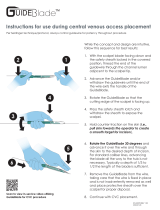
4
• Follow all contraindications, warnings, cautions, precautions and instructions for all
infusates, as specied by their manufacturer.
• After use, this product may be a potential biohazard. Handle and dispose of in accor-
dance with medical practice and applicable local, state and federal laws and regulations.
• As reported in literature, anaphylactic or anaphylactic-like reactions occur in a small
percentage of the population during placement
1
, positioning
1
, ushing
2
of catheters,
or cleaning of catheter exit site
3
. These reactions are reported in association with
insertion, rapid ushing, or manipulation of the catheter and/or use of chlorhexidine
gluconate (CHG) in some patients. Be aware of the potential symptoms or signs of
these reactions and take precautionary steps as dictated by institution protocol for their
prevention or treatment.
• If CHG allergy is suspected, conrmatory testing is recommended
4
,
5
• Caution: Federal (USA) law restricts this device to sale by or on the order of a physician.
• Only qualied health care practitioners should insert, manipulate and remove these
devices.
• Use aseptic techniques whenever the catheter lumen is opened or connected to other
devices.
Precautions Related to Device Placement Procedure
• DO NOT USE A SYRINGE SMALLER THAN 10 mL TO FLUSH AND CONFIRM PA-
TENCY. Patency should be assessed with a 10 mL syringe or larger with sterile saline.
Upon conrmation of patency, administration of medication should be given in a syringe
appropriately sized for the dose. Do not infuse against resistance.
• To reduce potential for blood backow into the catheter tip, always remove syringes
slowly while injecting the last 0.5 mL of sterile saline.
• Do not reinsert needle into IV catheter to minimize the risk of the needle damaging or
shearing the IV catheter.
• Do not cut guidewire to alter length.
• The stylet or stiffening wire needs to be well behind the point the catheter is to be cut.
NEVER cut the stylet or stiffening wire.
• Do not insert stiff end of guidewire into vessel as this may result in vessel damage.
• Keep sufcient guidewire length exposed at hub to allow for proper handling. A
non-controlled guidewire can lead to wire embolism.
• Do not use excessive force when introducing guidewire or microintroducer as this can
lead to vessel perforation and bleeding.
• If the guidewire must be withdrawn while the needle is inserted, remove both needle
and wire as a unit to prevent the needle from damaging or shearing the guidewire.
• Never leave stylet or stiffening wire in place after catheter insertion; injury may occur.
Remove stylet or stiffening wire and T-lock (as applicable) after insertion.
• Do not clamp extension leg when stylet or stiffening wire is in catheter to minimize the
risk of component or catheter damage.
• Never use force to remove the stylet. Resistance can damage the catheter. If resistance
or bunching of the catheter is observed, stop stylet withdrawal and allow the catheter
to return to normal shape. Withdraw both the catheter and stylet together approximate-
ly 2 cm and reattempt stylet removal. Repeat this procedure until the stylet is easily
removed. Once the stylet is out, advance the catheter into the desired position (zero
mark).
















